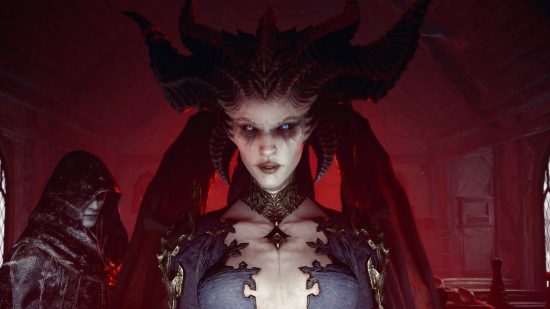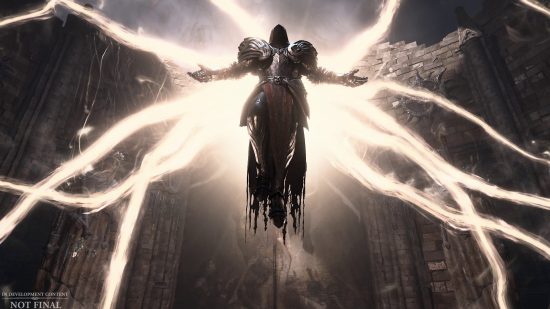I have been waiting for access to a Diablo 4 gameplay preview ever since the game was first announced. I have a vaguely cultish obsession with Lilith (trust me when I say I’d fit right into the D4 campaign), as well as an extensive history with all things Diablo. This action RPG series remains my favourite of all time, encompassing what I see as some of the best PC games ever made, and while I’ve only had a brief glimpse into the macabre world of Diablo 4, I’ve seen nothing yet to dampen my hype. Whisper it, but Blizzard might just have a hit on its hands – goodness knows it needs one.
As Diablo 4 opens, you’re met with the sound of the wind whistling through ancient, gnarled trees. Your character, riding a rather crestfallen horse, meanders through a montage of different environments, dismounting their miserable steed amid the frosted trees. As you push branches clear of your face your horse screeches in terror, running into the night, its neighs soon cut short by ominous crunching sounds and pitiful whinnying. You later discover that the beast has been gutted, its entrails scattered across the frozen ground beneath your fully customised character. Your torch spits and lets out one last crackle before succumbing to the blizzard, leaving you completely and utterly alone.
It’s a statement of intent. This is Diablo 4: it’s doom, and it’s gloom; it’s everything Diablo is supposed to be. There’s the darkness and grit that made Diablo 2 so special, and there’s a sense that every shadow is filled to bursting with something that wants to kill you – you can literally hear it (or them) squelching, growling, and plotting. As you traverse Sanctuary’s barren plains once more, it feels like you’ve stepped back in time to the good ol’ days of Diablo and Diablo 2. Gone are the shiny lasers and glistening halls of the High Heavens that alienated series veterans in Diablo 3 – this game isn’t about hope and glory, it’s about death, destruction, and chaos.
And that’s what you see from the outset. The starting area, Fractured Peaks, is equal parts beautiful and brutal. Your character trudges through the snow, which varies in height depending on the region; it can get so deep that you’ll see your character almost wading through it. The stalactite-ridden caves glisten with moisture – and often fresh blood – while the towering trees of the many forests all feel eerily oppressive – an impression enhanced by the mournful music that frames each step of your adventure.
The city states aren’t any friendlier. Kyovashad, the brutalist citadel that greets your traveller after the prologue, is dirty and riddled with chaos and despair. Even the refuge provided by the ever-holy church feels meagre, despite the grandeur of its deep scarlet carpet and golden artefacts. I’ve an especially vivid memory of a dying pig laying on a butcher’s table, contorting and twisting as death claimed it and rigor mortis kicked in. It turns your stomach, and is a harrowing reminder that nothing lasts long in the woeful world of Sanctuary.
If you thought the city was bad, just wait until you see the villages. You come across a small hamlet where the bodies of ‘sinners’ are suspended from a huge central structure like some sort of twisted totem pole. One local side quest sees you encounter the dismembered torso of an unfaithful husband who screams for you to… pleasure him. Yes, it’s vaguely scarring.
In short, everything just feels hopeless, and it’s absolutely glorious.
My favourite zone (so far) is the Black Lake. In scenes reminiscent of body horror game Scorn, the entire area feels somewhat alive, as tentacles that writhe and ooze coil around once-proud ruins and taint them with their vileness.
One disappointment, though, is that none of this imagination has made it into the optional cellar instances. As you might guess these are mini-dungeons, in which you dive into abandoned pits to clear out monsters and earn gear. These, unfortunately, are all the same – a rundown old cellar with a large square room off to the left hand side. I saw no variety in these, and it’s a little like Dragon Age 2 all over again: repetition, repetition, and some more repetition. It looks like there will be hundreds of these so I don’t expect each to be unique, but even a few variations would be nice.
Thankfully, Dungeon Producer Ash Sweetring assures me that “you can absolutely expect to see more variations” upon launch, noting “you may see variation as far as maybe intertwining with class or the campaign a little bit.” Breathe a sigh of relief, folks, the cellars are going to get even creepier.
Thankfully the combat keeps these instances from feeling too stale. I played as Rogue for my first playthrough – as a monk main it’s as close as I can get to a melee/ranged DPS hybrid – and the fluidity of the combat makes the most mysterious of the Diablo 4 classes an absolute joy. Again, it’s an early build, but the skill trees are already pretty extensive, allowing you to tailor your character to fit your playstyle. I went for a mix of melee and ranged attacks, adopting the ‘chunk them from afar and zip in and finish them’ playstyle. Abilities were easy to chain, dodging around made it easy to evade attacks, and all in all the class is lots of fun.
Enemies are challenging enough. I played on World Tier two, the highest level available in this test except hardcore, and I found myself getting absolutely mangled quite a few times. Often this was a result of having to work out new boss mechanics, but one particular fiend’s arena appears to be bugged, meaning that if you dodge into a certain section of the closed space your character is rooted and unable to move. While I eventually broke free of this using the Rogue’s mobility, it effectively decreases the playable zone, which isn’t ideal. I was also confronted with some pretty nasty stuttering (very Callisto Protocol), which was bad enough to keep me from beating the second boss. Early build and all that, and the game ran completely fine a day later and I was able to progress, but I’ll definitely be keeping an eye out for bugs in any future time with the game.

The only other slight disappointment for me was the character creator. We were informed that this build has the full wardrobe of customisation options, but if that’s so then they seem rather slim. There’s a vast array of markings and tattoos to choose from, but there aren’t many hairstyles or facial options to let you really tailor your character.
It isn’t a huge issue for me given the isometric nature of the game and the focus on combat, though. The options you have are very true to the ‘class fantasy’ of the character you’re playing, so I can understand Blizzard’s desire not to sacrifice that feeling by overcomplicating things. This fantasy is carried through the hair, eye, and armour colour palettes too – there are no neon pinks or bright yellows, so everything stays dark, bloodstained, and tatty.
Still, given how much Blizzard has promoted the character creation aspect of the game, a part of me wanted a little bit more. No doubt more options will be released as the game progresses through its live service journey (especially when the store opens and cosmetics are purchasable), but we’ll have to wait and see.
Even with these genuinely minor issues, Diablo 4 is easily the most exciting Diablo experience I’ve played simply because of the direction it hints at. It harks back to the gory glory of the series’ earlier games, but innovates upon the fluid combat that made Diablo 3 so great. We may actually be getting the best of both worlds.
Diablo 4 has been described countless times as an “extremely mature game,” and yes, it absolutely is. This looks to be Diablo at its best, rejuvenated by darkness and despair – and this was just a snapshot of what’s to come. For more about how the RPG turned out in the end, check out our Diablo 4 review, but until the Diablo 4 release date comes around, be sure to check out some best games like Diablo to keep you busy.



